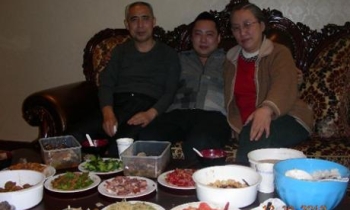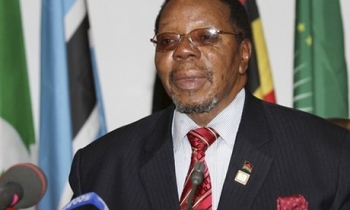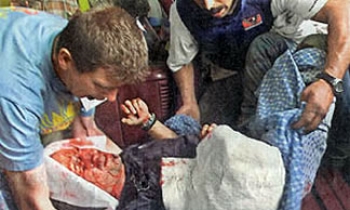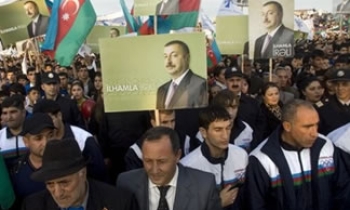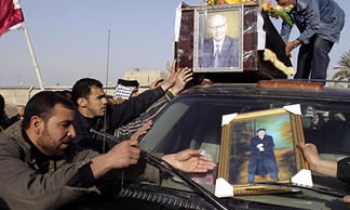If you saw the footage of Abdul Aziz Rantisi’s death on CNN two years ago or the Palestinian elections that were aired live on Nile News in January, you may have noticed the corner of the screen where it says “Courtesy of Ramattan.” This compelling footage from the streets of Gaza, Ramallah, Jerusalem, Rafah and countless other Palestinian towns was filmed by Palestinian cameramen, often at great personal risk, who work for Ramattan, a TV news agency founded by local journalists in 1999.
In just six years, the agency has grown to 25 cameras and 100 producers, reporters, cameramen, soundmen, satellite technicians and drivers. Initially based in Gaza, they now have offices in Ramallah, Jerusalem, Khan Younis and Cairo.
In the beginning, Ramattan was not a TV news agency in the strictest sense, as it only provided crews, pre-shot footage and other services to foreign and Arab correspondents. It did not have satellite uplink equipment, nor did it have the money, know-how or contacts to even rent space on a satellite. But in 2000, Ramattan saved a deal with Turkish news agency Ihlas (IHA), whose facilities allowed them to transmit their footage via satellite. In 2003, they split from IHA and under their own name they now provide daily feeds and breaking news via Eutelsat to their clients around the globe.
CNN pays $40,000 to be a monthly subscriber. Nile News and Egyptian state television use Ramattan’s footage regularly, as do other major networks.
Competing with giants including Associated Press Television News and Reuters Television, this small agency is not only surviving, but growing.
“We are struggling under the occupation. We are not a country with facilities allowing us to work, but you can make it if you believe in something, if you are professional and honest in your business,” says Qassem Ali, Ramattan’s general manager. “We are the most successful and maybe the only Palestinian outlet, and we don’t rely on donors or on the government. We survived and trained dozens of professionals.
“When Ahmed Yassin and Rantisi were assassinated, we were the only ones to have the pictures and transmit them within 24 hours,” he points out. “We always have a crew sitting downstairs around the clock and we always have a crew on the roof of the building. We have contacts with ambulance drivers and hospitals. The crew went straight there [to the site of Rantisi’s assassination], filmed five minutes of the car burning in Gaza and a driver took the tape by car to the office as they waited for the ambulance. We had three angles: from the roof, in the hospital and the real accident. We had pictures of Rantisi before he died. We put our name on it and all over the world people saw the Ramattan logo. Without that logo, for that footage, we could have made hundreds of thousands of dollars. I decided I wanted the publicity, I wanted the networks and the viewers to know about Ramattan.”
Keeping Ramattan independent has not been easy.
“We fought hard for our independence from both Fatah and Hamas. And there are resistance militias and mafias who don’t like free media. Sometimes, we felt our lives were at risk. We paid a heavy price for our independence; we have no help or protection,” Ali says. On the other hand, Ramattan also had to deal with Israel. “It is not something the Israelis felt they would like. The equipment bought from London had to get through Israel. It was hard, and we have sometimes had to smuggle it in.”
Born in the small Gaza Strip village of Beit Hanoun, Ali studied political science at Birzeit University. He supported the Popular Front for the Liberation of Palestine and was arrested by the Israelis, who detained him for three years. After his release, he began working as a reporter for the Associated Press and then started a private company providing services for WTN (now APTN) and Visnews (later renamed Reuters Television). After a short stint with ABC, Ali left for New York. Armed with a recommendation letter from now-deceased ABC Nightly News anchor Peter Jennings, he was accepted into the master’s of journalism program at New York University and later obtained a PhD in television production at Oxford University.
Ramattan isn’t without its critics. Fadi Abu Sada, a Palestinian journalist who founded Palestine News Network in 2000, an agency that relies on donors and provides free daily audio bulletins to Palestinian radio, says Ramattan is only looking for profit. Ali counters that rather than trying to maximize their profits, Ramattan has reinvested every penny into the training of a whole generation of Palestinian journalists.
“We started with one camera and trained the guy to edit and use it for work. CNN wants a crew, we charge them for a crew. RAI is making a documentary, we provide a soundman and cameraman. This is how we earned the money. Of course, this was not enough to run the training. And from that income, we had to buy more cameras and more equipment. I spent three or four years without taking my salary in order to be independent and not sell out.”
Being able to tell their story in their own terms is a huge achievement for many Palestinians, like founding cameraman and current Gaza Bureau Manager Shehadeh.
“As a Palestinian I have a device, the camera by which I can show the Israeli occupation and its bitter reality,” Shehadeh says. “The Palestinians are besieged from all sides. However, there was always a project motivating you to document those daily cases of killing, displacement and demolition. We can’t lose all these details. We are still alive — talking, filming and documenting this unforgettable history, serving our people.”
“Before, the Palestinians used to be covered from the Israeli side,” says Ali. “And when the camera is filming a demonstration from the soldiers’ side, even if the Palestinians only have stones in their hands, what you see is the demonstrators as aggressors, because the camera reflects this aggression, you don’t feel the danger of the bullets. Nobody was taking pictures from my side.”
But as CNN, BBC and others started using Ramattan’s footage, Ali started looking for a way to get out on his own satellite.
“Because Israeli air belongs to the Israelis under the Oslo accords, we would have had to transmit the footage through microwave transmission from Gaza to Jerusalem and then go onto the Israeli satellite. This was the biggest problem for us. The machines for uplink also have to be registered, and the equipment would have to go through them and would be confiscated. But finally we found a way through IHA. They had space on the satellite and could register the equipment in Turkey. We bought the equipment together and got it inside the country. How we did it, this is another story. For the Israelis we were illegal, but I don’t care because on this issue they are the occupiers. I wouldn’t do it in Egypt, in Syria, in Lebanon, where laws are fair for everybody.”
“Booking and billing went through Istanbul, and IHA could use their name, though it was my guys who risked getting shot on the streets. But in the beginning, we were looking for training and building Ramattan, to do something that is different. And for me it was better than working with the Israelis. We were finally transmitting from Gaza.”
Meanwhile, Ramattan also started to expand. One month before the Israeli invasion of 2001, they opened an office in Ramallah. “Tanks started coming to Ramallah. Ramattan’s office had one camera and one uplink. It was a small office. We went on air for CNN. We had a camera on the roof filming, and at three o’ clock in the morning it was ready for CNN. Nobody had it except them.”
The second Intifada was a turning point for Ramattan. Ben Wedeman, CNN’s Cairo bureau chief, says, “Before the Intifada, you could easily go from Jerusalem to Ramallah, shoot a story and go back to Jerusalem. With the Intifada, there were barriers everywhere, and it was no longer easy to go from Jerusalem to Ramallah or from Gaza to Tel Aviv. You needed to have a facility in these places where you could do everything. Over the years, they have proven to be dependable and professional and didn’t pull any tricks on us. [Ali] has a very good reputation among journalists. That’s what you need in this business: somebody who is dependable. And it’s not easy.”
Twice, when Ramallah was under siege, foreign reporters found in Ramattan not just a business partner, but also refuge. Wedeman, who was in Ramallah during the Israeli invasion of 2002, recalls how Ali turned the office into “a journalist refugee camp.” Reporters slept on mattresses borrowed from people in the neighborhood, and Ali cooked dinner and breakfast for everybody for two months.
By the time they split from IHA in 2003, Ramattan had managed to install the first of the 11 satellite uplinks it now owns, but the company makes most of its profit from providing services on the ground to networks and journalists, Ali points out. With costs ranging from $150,000 to $400,000 a month, Ali says he’s lucky to have a 10 percent profit margin.
In the meantime, at least two groups are looking to tap into Ramattan’s success by launching pan-Arab television news agencies. Middle East Network (MEN) now gathers news outlets including Al-Arabiya and MBC. More recently, Kuwaiti business mogul Jassim Al-Kharafi announced plans to launch the Arab News Agency (ANA) later this spring from a base in Cairo.
Ali says he has met ANA General Manager Hamed Ezz El-Din and thinks Ramattan may start covering Palestine for the new group. In the meantime, Ramattan isn’t sitting still: The agency plans to expand its operations to include Syria and Sudan, cooperating with local professionals to provide services to networks at first, just like they did in Gaza eight years ago.

